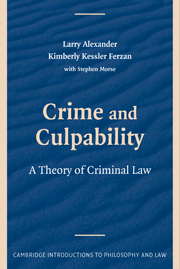Appendix
Published online by Cambridge University Press: 05 June 2012
Summary
General instructions:
It is criminal for an actor to take an unjustified risk of causing harm to a legally protected interest or to take an unjustified risk that his conduct constitutes prohibited behavior.
The following are harms to legally protected interests [list those applicable]:
Death
Fear of death
Serious bodily injury
Less serious bodily injury
Etc.
The law does not protect an individual from a risk of harm to which she consents. If the person subjected to the risk of harm knowingly and voluntarily consented to that risk, then the defendant cannot be liable for risking that harm. (An exception to this principle exists when the law specifically denies the capacity of the person to give legally effective consent to the particular risk in question.)
For behavior to be justified, the reasons that the actor has for engaging in his behavior should be weighed against the risk that the actor perceives that his conduct will cause a prohibited result or results.
An actor may never justify “appropriating” or “using” another human being (unless the appropriation is minor and the harm to be averted serious?).
The actor's reasons for action include not only the reason or reasons that motivate his conduct but also any other reason that might justify his conduct of which he is aware. These reasons should be accorded weight by (1) their positive or negative force and (2) the actor's perception of the likelihood that the facts underlying the reasons do or will obtain.
- Type
- Chapter
- Information
- Crime and CulpabilityA Theory of Criminal Law, pp. 327 - 330Publisher: Cambridge University PressPrint publication year: 2009



